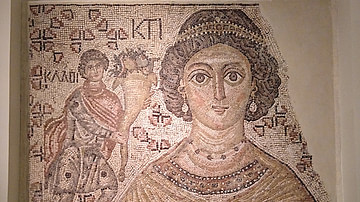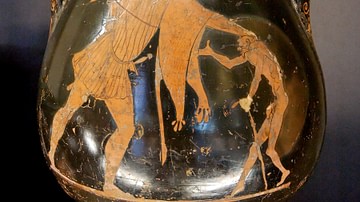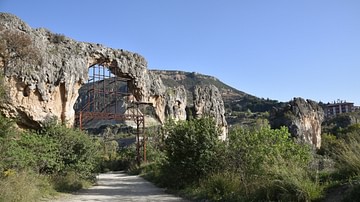Illustration
Late antique mosaic floor depicting Ktisis (Gr. ΚΤΙΣΙΣ), personification of 'Foundation', originally from a villa at Antioch, 5th century.
Worcester Art Museum.
The floor was found during the archaeological campaigns at ancient Antioch (modern-day Antakya, Turkey), led by Princeton University between 1932 and 1939. The mosaic belonged to a room in the so-called House of Ge and the Seasons, named after another floor mosaic in the villa depicting the goddess of the Earth, Ge (or Gaia), surrounded by the personified figures of the four seasons, all labeled by Greek inscriptions. The fragments depicting Ge and the Seasons are now in the Princeton University Art Museum.
Ktisis ('Foundation') is one of the most often depicted late antique personifications of abstract ideas. Such personifications, identifiable by their Greek name labels, were particularly popular in the Eastern Mediterranean. In contrast to other depictions of Ktisis, here she lacks her frequent attribute, the measuring rod for the Roman foot, which is present, for example, in her depiction in the Baths of Eustolios at Kourion, on Cyprus (in situ), or in a fragment from a floor mosaic now in the Metropolitan Museum of Art. She is, however, richly bejeweled, wearing a heavy diadem and pearl earrings, and as such comparable to other examples of this personification.
Like other late antique personifications of abstract qualities known from 5th- and 6th-century floor mosaics, the figure of Ktisis in the Worcester Art Museum is shown as an isolated bust portrait gazing at the viewer from a medallion placed in the center of the floor and set against a geometric carpet.
References
- Kondoleon, Christine (ed.). Antioch: The Lost Ancient City. Princeton: Princeton University Press, 2000
- Leader, Ruth. "Name Labels on Late Antique Mosaics." British Academy Review, January-July (2001), pp. 48-50.
- Levi, Doro. Antioch Mosaic Pavements. Princeton: Princeton University Press, 1947
External Links
Cite This Work
APA Style
Decheva, P. (2024, August 01). Personification of Ktisis from Antioch. World History Encyclopedia. Retrieved from https://www.worldhistory.org/image/19255/personification-of-ktisis-from-antioch/
Chicago Style
Decheva, Prolet. "Personification of Ktisis from Antioch." World History Encyclopedia. Last modified August 01, 2024. https://www.worldhistory.org/image/19255/personification-of-ktisis-from-antioch/.
MLA Style
Decheva, Prolet. "Personification of Ktisis from Antioch." World History Encyclopedia. World History Encyclopedia, 01 Aug 2024. Web. 30 Mar 2025.








